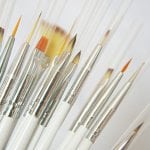Acrylic brushes are different. The nylon brush has proven itself best, but it is not suitable for all types of work, so it cannot become the only artist in the arsenal. Before buying this or that brush, you should figure out whether it is suitable for acrylic and for the specific features of a particular artist.
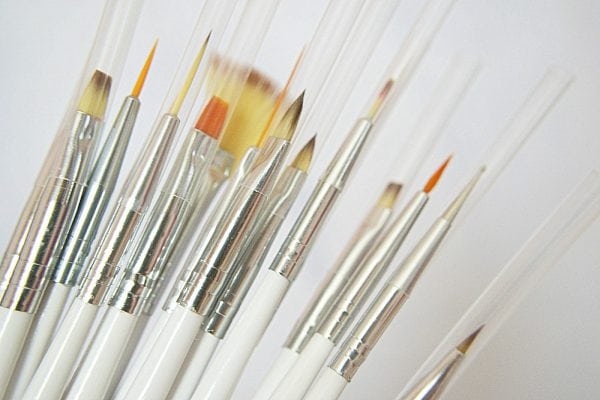
Brush shapes
You can work with acrylic with a tool of any shape, but each of the brushes is capable of performing a certain amount of work during drawing. It is very easy to spoil a picture if you choose the wrong brush shape for certain strokes.
- Round. This tool is considered universal, suitable for any paints and techniques. They can be used to draw parts or fill, depending on the brush number. The round shape is achieved by enclosing the pile in a round clip.
- Flat. To create this shape of a brush, a flat clip is used. The brushes can be wide and narrow, long and short. They are conveniently used for painting large areas of a painting with plain paint, including acrylic.
- Contouring. The shape of such brushes is similar to a flat one, but the tuft of pile is shortened and wider, making smears easier to control. It’s also convenient to create color brushes with contour brushes. color transitions.
- A cat-shaped brush. The shape of such an instrument resembles a dome or oval. It is considered a compromise between the round and flat brushes, because depending on the position leaves different strokes. For beginners, the tool is not suitable, since its use requires some skill.
- Linear To create such a brush, a long pile is taken, and the thickness of the tool is very small. The brush is more suitable for inscriptions or very thin, small details.
There are several more types of brushes, for example, screen or font, but they are much less suitable for drawing acrylic than the above.
to contents ↑Types of brushes
For painting with acrylic paints, both hard and soft brushes are suitable. Each has its own advantages and disadvantages and is used in certain techniques.
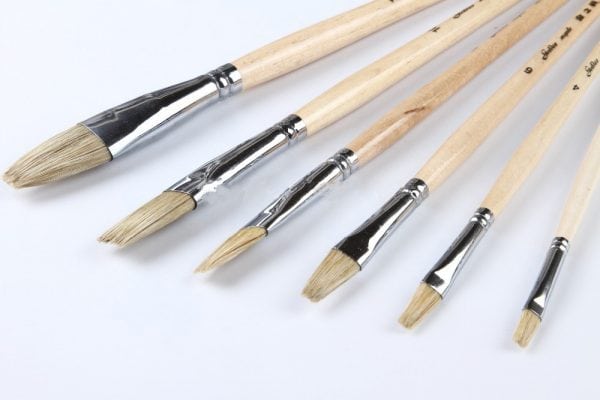
Soft brushes
Such tools, which are mostly made from natural materials, hold paint well and are suitable not only for acrylic, but also for watercolor and gouache. Artists use them to apply fine, neat lines or to represent translucent tones. Using a soft brush it’s easy to draw small details.
The best natural, soft brush is considered to be sable. However, acrylic paints easily spoil this type of pile, so it is not recommended to use it.An alternative is considered to be a brush made half from sable, half from synthetic material. Well, a cheaper and more common alternative is a synthetic brush.
to contents ↑Hard brushes
In addition to weightless layers, acrylic paint is used for applying thick strokes. Using acrylic, you can apply various relief and rough techniques, which require hard brushes, which hold a lot of paint, and strokes are clearer.
The brush for painting with acrylic should not only be stiff, but also flexible enough and flexible so that the strokes are smooth and do not spoil the picture.
Modern painting tools meet the desired characteristics and are made of synthetic materials. Depending on the techniques used by the artist, a stiff brush can be large or small, have a different width, the length of the handle.
to contents ↑
Brush sizes
To determine what sizes of brushes are needed for a particular style of acrylic painting, you need to gain some experience. When choosing a brush number, one should take into account the fact that the numbering may differ from different manufacturers, so if you find the best option for drawing, you should buy tools from only one company.
The numbering of the brushes starts from one and reaches 16 (sometimes 14). The thickness of the smear increases accordingly. However, the difference between the brushes is not only in width, but also in the length of the handle. Soft tools are shorter, harder - longer, which allows you to draw at a certain distance from the canvas and better evaluate the picture.
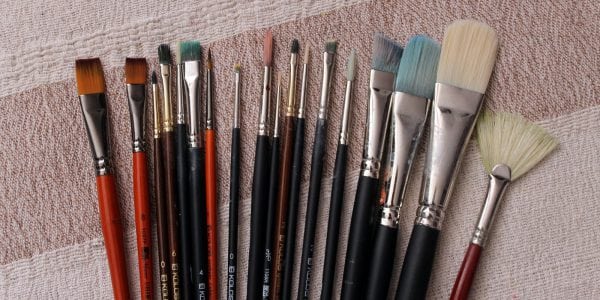
Nylon brush
A nylon brush is considered the best option for aspiring artists who prefer acrylic. It is synthetic, has many varieties of shapes and sizes.
The main advantages of a brush made of nylon pile:
- Elasticity. The material from which the tool is made has high elastic properties, does not break when bent, and is quite resilient and elastic. The strokes of the paint that such a brush leaves are smooth and clear. It is easy to paint with a nylon brush even for beginners, as it is the middle option between hard and soft.
- Strength. The main problem of natural brushes in acrylic painting is the need to keep them in water. Due to this attitude, the pile falls out and deteriorates, which, however, does not apply to this synthetic brush. From a long stay in water, the tool will not serve less, therefore it is suitable for acrylic.
- Ease of care. Due to the fact that the brush is made of synthetics, it is easy to clean it from acrylic, which is famous for its quick drying and pestering to pile. Natural brushes are very difficult to put in order, since their structure is not smooth, like in nylon. To care for such a brush, it is enough to rinse it after use with a stream of water.
It is worth noting that the nylon brush, although very good, can not be an alternative to all other types of tools. Experienced artists, in any case, will have in stock several other types of brushes, for some specific techniques.
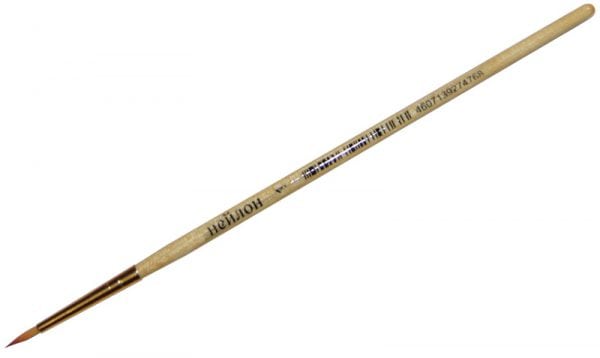
Brush care
Acrylic paint differs in that no matter what technique the artist uses and no matter how much he is fond of the process, he must ensure that the brushes do not dry out. Acrylic dries very quickly and then the tools can be considered damaged.To prevent this, you need to keep the brushes in the water while drawing, which gradually spoils them, but at least does not disable them.
The process of cleaning the brush after painting:
- excess paint after finishing work must be removed with a rag or thick paper, carefully wiping the brush on them;
- then the brush falls into the water, and rotational movements are made, with the help of which acrylic is removed from the pile;
- the tool is wiped with a rag and soaped with soap;
- then the soap needs to be washed off, making sure that it falls between the pile and under the clip (so that the brush lasts longer, even the smallest paint residues must be removed);
- the brush should be washed to clear water, after which it is wiped dry and the pile is allowed to dry (the bundle should be directed upward and the brush should be given the correct shape beforehand).
If the acrylic is still dry on the brush, you can try to remove it by soaking it in a special cleaning agent, and then gently remove the paint residues with a wooden toothpick, after pressing the brush to a hard surface.
In general, for work with acrylic paintsshould use synthetic brushes. The shape and size are selected individually, but for beginners it is best to purchase several standard brush options. When working with acrylic, great attention should be paid to the care of tools, since the paint dries quickly and spoils the pile.

